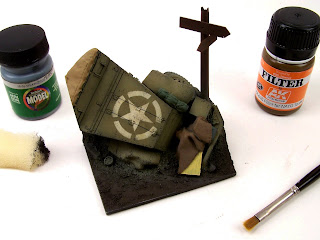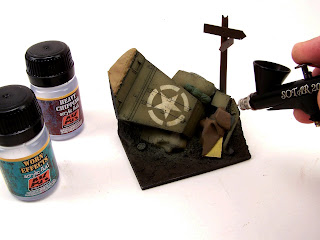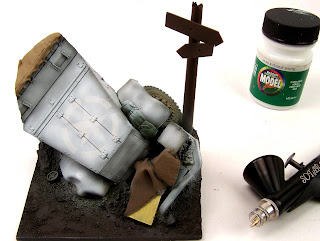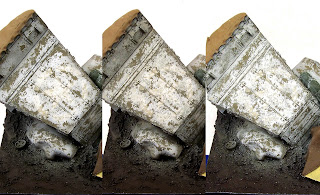So I've been a bit distracted with a few other things over the last few days but work continues on this project. I am thoroughly enjoying how quickly these come together and while I don't see myself giving up on full sized dioramas with complete vehicles and several figures, it is very refreshing to get so far, in such short time. I can guarantee a few more of these in my near future
After applying some filters to the half track I began adding some Dark Earth pigments to the base. I have applied these to represent the dirt on the ground but I have also applied them in a thin wash like mixture to a few areas on the vehicle. I suspend the pigments in the fixer to the effect of say, dirty water. Feathering this in around a few areas will help to tie the two together and set the scene. I assume this half track was pushed up and out of the way to clear a path for the passing armor. Considering this, I assume the dirt would have been thrown up onto the vehicle a bit.

In this next photo we can see the effect of the pigments on the fender and grill and along the lower section of the hood. It has made an impression without overpowering the surface, this should be the goal: subtlety.
Once the pigments were set, I used a little AK Interactive Engine Oil to further support the idea of a disabled and abandoned half track. Perhaps the oil pan was tore open as it got pushed up onto the bank. Once the first coat absorbed into the pigments I applied a second coat, closer to the center and then later a third, slowly building up the color of fresh oil and also allowing the impression of it soaking into the surrounding earth.

I mixed some Woodland Scenics snow with the AK Interactive Wet Effects and applied it in various areas, in an attempt to portray slushy piles of melting snow. I reapplied the Wet Effects in areas where the pigments absorbed it, dulling the gloss effect and will continue to do so as the product dries until I am happy with the outcome. Often times one application of something doesn't always produce the desired effects and depending on the surrounding elements, reapplications are needed.

Lastly for today even though not complete, I will share just a sneak peak at the figure simply standing in place. I just wanted to see where I was heading and show it here to anyone interested as well.
I think in the end, the figure will help to tell the story and is a very important part of the setting. I am by no means a figure painter but I think at least one is needed on this small scene and I make do with what meager ability's I have.













